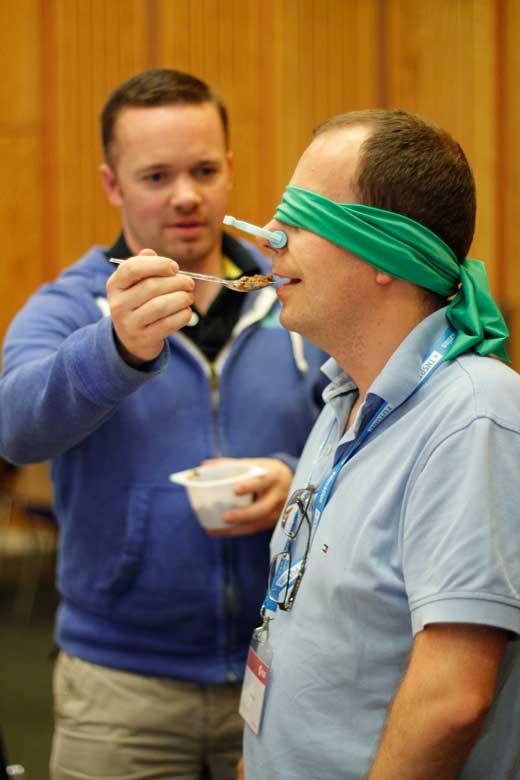Space for all the sciences: the ESA teachers workshop Inspire article
In July 2015, 120 teachers from around Europe converged at ESA to learn how to use space as a context for broader teaching.

smell food gets you a sense
of what it is like to eat in
space.
Image courtesy of ESA / A
Conigli
Noordwjik on the north coast of the Netherlands is not just home to windswept beaches. For three days in July 2015, it also hosted 120 European teachers who had come to learn about space. The European Space Agency (ESA)’s European Space Research and Technology Centre (ESTEC) opened its doors to share classroom activities and to enable teachers to network. The 2015 summer teachers workshop was the largest yet, and for the first time, primary-school teachers were included on the guest list.
Head of the STEM Education and Outreach Unit at ESA (and Science in School editorial board member), Monica Talevi, welcomed the group and explained the purpose of the workshop. ESA’s commitment to education is written into the agency’s charter and ESA must put its findings into the service of education. Yet that doesn’t just mean physics education, as Talevi made clear: “There is no STEM [science, technology, engineering and maths] subject that can’t be covered by space,” she emphasised.
The workshop programme was built around five key topics – gravity, Rosetta, planet Earth, light, and human space exploration. Each session started with a plenary for all the teachers before the groups split into primary- and secondary-school sessions.
There was a great deal of excitement when eminent speakers such as Rosetta project scientist Matt Taylor, ESA astronaut André Kuipers, award-winning solar astrophysicist Pål Brekke, and ESA Copernicus space segment manager Guido Levrini gave talks, and teachers rushed up afterwards for photos and autographs. But the real enthusiasm came during the sessions that followed, in which the teachers were given the opportunity to try the space-related activities for themselves.
For example, while primary-school teachers were making craters and talking more about how comets can be ‘time capsules’ in space, secondary-school teachers were busy cooking up their own comet from dry ice, carbon and Worcestershire sauce. All of the activities presented are, or will be, available from the ESA website as part of the ‘Teach with Rosetta’ projectw1. “We know that space science inspires,” explained Anu Ojha, director of the National Space Academy in the UK, who presented some of the activities in the secondary-school sessions. “You can take many of these themes to teach fundamental topics from the physics, chemistry, biology and mathematics curricula across Europe.”
One of the popular activities on the Teach with Rosetta website has been the ‘Pixel your space’ activity (see EIROforum, 2015, for more details) which was done on a huge scale at Noordwjik as an activity to encourage the participants to relax and get to know each other at the beginning of the workshop. Silence descended as 120 teachers got out their pencils, rulers and glue sticks to put together part of a huge image that eventually spread across the floor of the seminar room (see video below). By the end of the workshop there was no stopping the networking. For the teachers who wanted to continue what they started in Noordwjik, various online groups have been set up to continue the conversation. ESA also has space education resource offices around Europe (known as ESEROs) to help share resources and best practicew2. “I’m looking forward to working with ESERO Ireland and Science Foundation Ireland to develop exciting workshops,” said Irish primary-school teacher Carla Hayes.
European teachers will be invited to apply for the next workshop, taking place in Summer 2016. The workshop will be advertised on the ESA website and in Science in School. Priority will be given to those who have not attended before and to teachers who are committed to sharing what they have learned with their colleagues.
More about ESA

The European Space Agency (ESA)w3 is Europe’s gateway to space. Its mission is to shape the development of Europe’s space capability and ensure that investment in space continues to deliver benefits to the citizens of Europe and the world.
ESA is a member of EIROforumw4, the publisher of Science in School.
References
- EIROforum (2015) Pixels, pictures and powering up. Science in School 32: 2-5
Web References
- w1 – For more information on the ‘Teach with Rosetta’ resources, visit the project’s website.
- w2 – To find out more about the project, and to find your nearest ESERO office, visit the ESERO website.
- w3 – Get more information about ESA.
- w4 – EIROforum is a collaboration between eight of Europe’s largest inter-governmental scientific research organisations, which combine their resources, facilities and expertise to support European science in reaching its full potential. As part of its education and outreach activities, EIROforum publishes Science in School.





